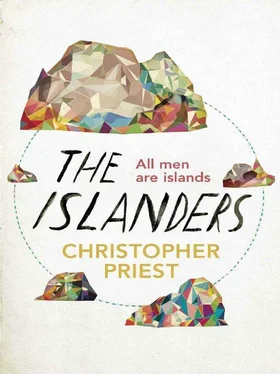Naturally, this theory had not been formulated at the time. Dryd Bathurst left Siff in the way which was commonly associated with him: suddenly and in conditions of urgent secrecy. He was never to return. But the popular success of his enormous painting brought Siff to wider attention throughout the Archipelago. Then as now tunnelling was a popular pastime with many people, but there were critically few places where it was allowed to be carried out. Tunnellers descended eagerly on Siff from all over the Archipelago. Soon tunnels were being excavated in every part of the island.
The first major collapse occurred about a century after Bathurst’s painting became known. Siff Town, by then thoroughly undermined, had to be evacuated and within another half-century the island was entirely abandoned to the teams of tunnellers.
Although many tunnellers were to die in the years ahead, the honeycombing of the island continued to its tragic and inevitable conclusion. In its final years, Siff fell silent: even the gales and storms could no longer find a tune to strike from the broken, gaunt and crumbling crags that the little island had become.
Siff’s final collapse was witnessed by only a few. There is a poor-quality video of the last few moments, and this can be viewed in the museum on neighbouring Gençek. It makes depressing viewing. More than five hundred tunnellers died in the flooded galleries and passages during that terrible day. Today, their only memorial is under the clear, shallow seas where Siff once rose above the unforgiving waves.
Smuj
OLD RUIN / STICK FOR STIRRING / CAVE WITH ECHO
By Dant Willer, IDT Political Editor, writing for Travel & Vacation Supplement, Islander Daily Times . Although never published in the newspaper, this short essay has been available online from the IDT website for several years.
It began as a routine assignment for this newspaper, the sort of travel story I have been writing on and off for many years. As readers will know my by-line appears more often in the main part of the newspaper reporting politics or the economy, but all the staff here at IDT are given occasional travel assignments. Someone, we console ourselves as we pack our sandals and sun block, has to do these things.
The reader we have in mind is someone who might be thinking of taking a trip or a holiday. For those who are not we try to convey a reliable idea of what the destination is like. Travel journalism is not important in itself and only rarely has a wider relevance — for each reporter it can be a gentle reminder that there is more to life than trying to break a major news story.
My assignment, only the third in as many years, was to visit SMUJ. Why Smuj? everyone asked, including myself before I set out. Joh, the chief editor of the T&V Supp , said, ‘Your question provides its own answer. It’s a place no one seems ever to have heard of. There is no better reason for going there.’
So, in the spirit of seeking the hidden, the lost, the forgotten, the unknown, the undiscovered, I set out to explore Smuj. The first challenge was to find it.
As regular readers know, the IDT no longer publishes maps. The official reason for this is because most maps of the Archipelago are notoriously inaccurate, but our former policy was that an approximate map was better than no map at all. However, the newspaper had to revise this policy when a few years ago the T&V Supp inadvertently sent a group of retired church workers to a Glaund Army rest and recreation base on the island of Temmil. Perhaps that is largely anecdotal, but the lesson was learned. Instead of printing an unreliable map now we give details instead of how we travelled to the destination, and leave it to our readers to follow in our steps. This is always the hardest part of the assignment, as here in the IDT office we are not even allowed to use the unreliable maps printed by our rivals.
So my search for Smuj began. All I knew at the outset was that it is somewhere in the seas between Paneron and Winho, and is often said to be obscured behind the magnificent Coast of Helvard’s Passion. As I began my search on the internet — a first resort for everyone — a website assured me that Smuj was so well hidden within its own mysteries that even today the people who come from there, should they leave their enigmatic homeland to venture into the wider, mapless reaches of the Archipelago, will maintain the fiction of its inaccessibility and lament the impossibility of their ever being able to return.
It is all, I am a little sad to report, a romantic fiction. Smuj can be found. Neither immediately, quickly nor easily, but it is there to be found. All that is necessary is to forage through the small print of the ferry services in the approximate area and you will find that regular services are there. Not advertised, I should add, but certainly there.
Because I wish to encourage you to follow in my footsteps, I can save you the task of foraging. I chose to travel to Smuj on the scheduled services run by the Skerries Line, one of the smaller ferry operators in that part of the Archipelago.
The ship picked me up as the brochure said it would, and it departed and arrived on time at every port of call. There are many of these stopovers but they are greatly varied. The comfort on board for passengers was plain but of a completely acceptable standard, and the ship neither sank, went aground nor played loud music on its public address system. The cabins were air conditioned. While on board there was full, if occasionally intermittent, internet access. The shaded decks were adequate protection from the sun, and the steward service was good.
At one point in the voyage I was so lulled into a sense of contentment that I even thought, given the time and the funds, that I should like to spend the rest of my life cruising slowly through the Dream Archipelago. I loved the endless cerulean seas, the beneficent breezes, the tropical warmth, the attendant seabirds and surfacing dolphins, and of course the passing show of islands and rocky passages and glasslike calms. At night too the spectacle continued: we frequently saw the diamanté glitter of the lights in houses and towns, sometimes burning a path of bright colours across the dark sea towards our ship. I was therefore not all that pleased to disembark on Smuj, but because in reality I have neither the time nor the money to spend the rest of my life on boats, I was not sorry either.
On arrival I found, as half-expected, a small island, charming and unspoilt, with many of the conventional, expectable attractions for visitors. The swimming is safe and there are several uncrowded beaches and coves to choose from. The scenery is modest but appealing. There are quiet mooring places for private yachts all around the coast. Scuba diving on the reefs is recommended. There is no casino, but once a year there is a horse-racing event. As for eating, the standard of cuisine in the restaurants I went to was normally better than adequate and at best of world-class excellence. Private or rental cars are not allowed on Smuj, but two-stroke mopeds may be rented on a daily or weekly basis. The proprietors of several of the hotels I went to in Smuj Port claimed to have recently installed internet access, but I was unable to confirm this.
Smuj is one of the few islands I have visited where there is inter-ethnic tension. For some reason Smuj has inherited three different vernacular patois systems, but none of them is dominant over the other two. It seems apparent to me that should the tourist trade increase then the influx of visitors will have the same unifying effect on the locals it has everywhere else, but that has not yet happened. One of the curious sights and sounds at the end of the long hot days on Smuj is the evening promenadá, where parading individuals and families exchange remarks, clearly mildly offensive, in street language the recipient probably does not understand, while the meaning is not in doubt. The mood is aggressive, but also somehow good-natured, almost a ritual. Rude hand signals do not a civil war make! Balancing this is the obviously high level of interested interaction between opposite members of sex in the young people. Perhaps within the next generation this conflict will die out, if only for this reason.
Читать дальше











